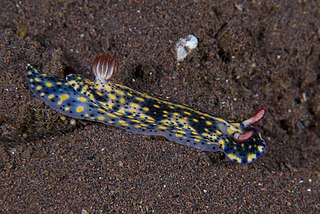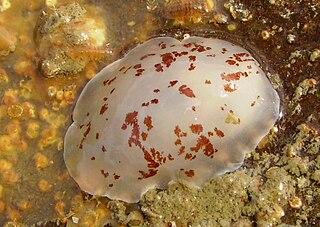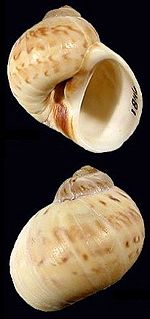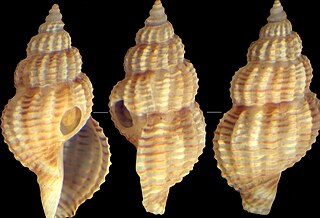
The Pleurobranchidae are a taxonomic family of sea slugs, marine gastropod molluscs in the clade Pleurobranchomorpha.

Felimare picta is a species of colourful sea slug or dorid nudibranch, a marine gastropod mollusk in the family Chromodorididae. Atlantic Ocean species of Hypselodoris were all transferred to Felimare following a DNA phylogeny.

Hypselodoris infucata is a species of colourful sea slug or dorid nudibranch, a marine gastropod mollusk in the family Chromodorididae.

Berthella ornata is a species of sea slug, a marine gastropod mollusk in the family Pleurobranchidae. It is sometimes called the Ornate side-gilled sea slug.

Pleurobranchus is a genus of sea slugs, specifically side-gill slugs, marine gastropod mollusc in the family Pleurobranchidae.

Gibbula albida, common name the whitish gibbula, is a species of small sea snail, a marine gastropod mollusc in the family Trochidae, the top snails.

Euspira nitida is a species of sea snail, a marine gastropod mollusc in the family Naticidae, the moon snails.

Leufroyia leufroyi is a species of sea snail, a marine gastropod mollusk in the family Raphitomidae.

Naria ocellata, common name the ocellate cowry, is a species of sea snail, a cowry, a marine gastropod mollusk in the family Cypraeidae, the cowries.

Cumia reticulata, common name the false triton, is a species of sea snail, a marine gastropod mollusk in the family Colubrariidae. Out of this family, there are at least 6 species that are known to feed on blood. This trait of feeding on blood is likely shared by the entire family.

Berthella is a genus of sea slugs, marine gastropod mollusks in the family Pleurobranchidae.

Berthella martensi is a species of sea slug, a marine gastropod mollusk in the family Pleurobranchidae.

Janolus cristatus, sometimes known by the common name crested aeolis, is a species of nudibranch, a marine gastropod mollusc in the family Proctonotidae.

Spurilla neapolitana, the Neapolitan spurilla, is a species of sea slug, an aeolid nudibranch, a marine gastropod mollusk in the family Aeolidiidae. It is native to the western Atlantic Ocean, the Caribbean Sea and the Mediterranean Sea. This species was first described as Eolis neapolitana by the Italian naturalist Stefano delle Chiaje in 1841. However, although some authorities quote the year as 1823, the species does not appear in the first volume of delle Chiaje's memoirs, which was published that year. The species was later reassigned to the genus Spurilla.
Knoutsodonta neapolitana is a species of sea slug, a dorid nudibranch, a shell-less marine gastropod mollusc in the family Onchidorididae.

Solecurtus strigilatus, also known as the rosy razor clam, is a species of saltwater clam, a marine bivalve mollusc in the family Solecurtidae. This mollusc is a suspension feeder and can burrow with great rapidity to escape predators. It is an unusual bivalve in that its shell valves are too small to contain all the soft tissue, and the animal is unable to retreat into its shell.
Mangelia neapolitana is a species of sea snail, a marine gastropod mollusk in the family Mangeliidae, the cone snails and their allies.
Acanthochitona crinita is a species of marine chiton in the family Acanthochitonidae. It is found on rocky coasts in the northeastern Atlantic Ocean, the North Sea and the Mediterranean Sea.
Corticium candelabrum is a species of sponge in the order Homosclerophorida. It is native to the eastern Atlantic Ocean and the Mediterranean Sea where it inhabits the shallow sublittoral zone. The type locality is the Adriatic Sea.











